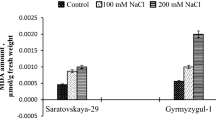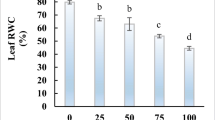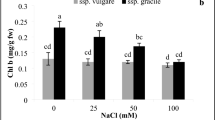Abstract
Nasturtium officinale R. Br. seedlings were treated with a range of NaCl concentrations (0, 50, 100 and 150 mM) for 21 days after seedling emergence. Physiological analysis based on growth and mineral nutrition, showed a substantial decrease in leaf dry matter with 150 mM NaCl treatment. The growth decrease was correlated with nutritional imbalance and a reduction in potassium accumulation and transport to the leaves. At the same time, we noted an increase in leaf sodium and chloride accumulation and transport. Salt tolerance of N. officinale under 100 mM NaCl was associated with osmotic adjustment via Na+ and Cl− and the maintenance of high K+/Na+ selectivity. Salt decreased carotenoid content more than chlorophylls and also disturbed membrane integrity by increasing malondialdehyde content and electrolyte leakage. At 150 mM NaCl, an increase in antioxidant enzyme-specific activities for superoxide dismutase, catalase and guaiacol peroxidase occurred in concert with a decrease in ascorbic acid, polyphenol, tannin and flavonoid content. These results indicate that N. officinale can maintain growth and natural antioxidant defense compounds such as, vitamin C, carotenoids, and polyphenols, when cultivated in 100 mM NaCl, but not at higher salt levels.






Similar content being viewed by others
Abbreviations
- DW:
-
Dry weight
- FW:
-
Fresh weight
- D:
-
Day
- Chl:
-
Chlorophylls
- CAR:
-
Carotenoids
- EL:
-
Electrolyte leakage
- MDA:
-
Malondialdehyde
- SOD:
-
Superoxide dismutase
- CAT:
-
Catalase
- POD:
-
Guaiacol peroxidase
References
Abogadallah GM (2010) Antioxidative defense under salt stress. Plant Signal Behav 5(4):369–374
Asada K (2006) Production and scavenging of reactive oxygen species in chloroplasts and their functions. Plant Physiol 141:391–396
Ashley M, Grant M, Grabov A (2006) Plant responses to potassium deficiencies: a role for potassium transport proteins. J Exp Bot 57:425–436
Ashraf M (2009) Biotechnological approach of improving plant salt tolerance using antioxidants as markers. Biotechnol Adv 27:84–93
Athar HR, Khan A, Ashraf M (2008) Exogenously applied ascorbic acid alleviates salt-induced oxidative stress in wheat. Env Exp Bot 63:224–231
Awika JM, Rooney LW, Wu X, Prior RL, Zevallos LC (2003) Screening methods to measure antioxidant activity of sorghum (Sorghum bicolor) and Sorghum products. J Agric Food Chem 51:6657–6662
Berthomieu P, Conejero G, Nublat A, Brackenbury WJ, Lambert C, Savio C, Uozumi N, Oiki S, Yamada K, Cellier F et al (2003) Functional analysis of AtHKT1 in Arabidopsis shows that Na+ recirculation by the phloem is crucial for salt tolerance. EMBO J 22:2004–2014
Beyer WF, Fridovich I (1987) Assaying for superoxide dismutase activity: some large consequences of minor changes in conditions. Anal Biochem 161:559–566
Bielski BH, Richter HW, Chan PC (1975) Some properties of the ascorbate free radical. Ann NY Acad Sci 258:231–237
Boulos L (1983) Medicinal plants of North Africa. Reference Publications, Algonac Michigan
Bradford MM (1976) A rapid and sensitive method for quantitation of microgram quantities of protein utilizing the principle of protein-dye binding. Anal Biochem 72(1–2):248–254
Brody SS, Chaney SE (1966) Flame photometric detector. J Gas Chromatogr 4:42
Chance B, Maehly SK (1955) Assay of catalase and peroxidases. Method Enzymol 2:764–775
Cramer GR, Urano K, Delrot S, Pezzotti M, Shinozaki K (2011) Effects of abiotic stress on plants: a systems biology perspective. BMC Plant Biol 11:163–177
Dai J, Mumper RJ (2010) Plant phenolics: extraction, analysis and their antioxidant and anticancer properties. Molecules 15(10):7313–7352
DeFord DD (1960) Electroanalysis and coulometric analysis. Analy Chem 32(5):31–37
Dewanto V, Wu X, Adom KK, Liu RH (2002) Thermal processing enhances the nutritional value of tomatoes by increasing total antioxidant activity. J Agric Food Chem 50:3010–3014
Dionisio-Sese ML, Tobita S (1998) Antioxidant responses of rice seedlings to salinity stress. Plant Sci 135:1–9
El-Ghorab AH, Shibamoto T, Ozcan M (2007) Chemical composition and antioxidant activities of buds and leaves of capers (Capparis ovata Desf. Var. Canesencene) cultivated in Turkey. J Essent Oil Res 19:72–77
Fielding JL, Hall JA (1978) Biochemical and cytochemical study of peroxidase activity in roots of Pisum sativum. J Exp Bot 29:969–981
Flowers TJ (2004) Improving crop salt tolerance. J Exp Bot 55:307–319
Frary A, Gol D, Keleş D, Okmen B, Pınar H, Şığva HO, Yemenicioğlu A, Doğanlar S (2010) Salt tolerance in Solanum pennellii: antioxidant response and related QTL. BMC Plant Biol 10:58–74
Fridovich I (1975) Superoxide dismutase. Ann Rev Biochem 44:507–523
Gassmann W, Rubio F, Schroeder JI (1996) Alkali cation selectivity of the wheat root high-affinity potassium transporter HKT1. Plant J 10:869–882
Gorham J, Wyn Jones RG, Bristol A (1990) Partial characterization of the trait for enhanced K+–Na+ discrimination in the D genome of wheat. Planta 180:590–597
GRIN (Germplasm Resources Information Network) (2012) [USDA Online Database]. National Germplasm Resources Laboratory, Beltsville, Maryland. URL: http://www.ars-grin.gov/cgi-bin/npgs/html/taxon.pl?25072 (08 May 2012)
Hachicha M (2007) Les sols salés et leur mise en valeur en Tunisie. Secheresse 18:45–50
Harinasut P, Srisunak S, Pitukchaisopol S, Charoensataporn R (2000) Mechanisms of adaptation to increasing salinity of mulberry: proline content and ascorbate peroxidase activity in leaves of multiple shoots. Sci Asia 26:207–211
Hattori K, Konomi M, Osumi M, Yamagami M, Schroeder JI et al (2005) Enhanced salt tolerance mediated by AtHKT1 transporter-induced Na unloading from xylem vessels to xylem parenchyma cells. Plant J 44:928–938
Hauser F, Horie T (2010) A conserved primary salt tolerance mechanism mediated by HKT transporters: a mechanism for sodium exclusion and maintenance of high K+/Na+ ratio in leaves during salinity stress. Plant Cell Env 33:552–565
Heath RL, Packer L (1968) Photoperoxidation in isolated chloroplasts. I. Kinetics and stoichiometry of fatty acid peroxidation. Arch Biochem Biophys 125:189–198
Hoagland DR, Arnon DI (1950) The water-culture method for growing plants without soil. Calif Agric Expt Sta Circ 347:1–32
Horie T, Yoshida K, Nakayama H, Yamada K, Oiki S, Shinmyo A (2001) Two types of HKT transporters with different properties of Na+ and K+ transport in Oryza sativa. Plant J 27:129–138
Hussain K, Majeed A, Nawaz K, Hayat KB, Nisar MF (2009) Effect of different levels of salinity on growth and ion contents of black seeds (Nigella sativa L). Curr Res J Biol Sci 1:135–138
Imaida K, Fukushima T, Shivai T, Ohtani M, Nakanishi K, Ito N (1983) Promoting activities of butylatedhydroxyanisole and butylatedhydroxytoluene on 2-stage urinary bladder carcinogenesis and inhibition of ç-glutamyltranspeptidase-positive foci development in the liver of rats. Carcinogen 75(4):895–899
Iturbe-Ormaetxe I, Escudero PR, Arrese-Igor C, Becana M (1998) Oxidative damage in pea plants exposed to water deficit or paraquat. Plant Physiol 116:173–181
Jabnoune M, Espeout S, Mieulet D, Fizames C, Verdeil JL, Conejero G, Rodriguez-Navarro A, Sentenac H, Guiderdoni E, Abdelly C et al (2009) Diversity in expression patterns and functional properties in the rice HKT transporter family. Plant Physiol 150:1955–1971
** X, Huang Y, Zeng F, Zhou M, Zhang G (2009) Genotypic difference in response of peroxidase and superoxide dismutase isozymes and activities to salt stress in barley. Acta Physiol Plant 31:1103–1109
Kaddour R, Nasri N, M’rah S, Berthomieu P, Lachaâl M (2009) Comparative effect of potassium on K and Na uptake and transport in two accessions of Arabidopsis thaliana during salinity stress. C R Biol 332:784–794
Kampfenkel K, Van Montagu M, Inzé D (1995) Extraction and determination of ascorbate and dehydroascorbate from plant tissue. Anal Biochem 225:165–167
Katsuhara M, Otsuka T, Ezaki B (2005) Salt stress-induced lipid peroxidation is reduced by glutathione S-transferase, but this reduction of lipid peroxides is not enough for a recovery of root growth in Arabidopsis. Plant Sci 169:369–373
Lebaudy A, Very AA, Sentenac H (2007) K+ channel activity in plants: genes, regulations and functions. FEBS Lett 581:2357–2366
Lemordant D (1977) Plantes utiles et toxiques de Tunisie. Fitoterapia 18:191–214
Lichtenthaler HK (1988) Chlorophylls and carotenoids: pigments of photosynthetic biomembranes. Meth Enzymol 148:350–383
Mahajan S, Tuteja N (2005) Cold, salinity and drought stresses: an overview. Arch Biochem Biophys 444:139–158
Mäser P, Eckelman B, Vaidyanathan R, Horie T, Fairbairn DJ, Kubo M, Yamagami M, Yamaguchi K, Nishimura M, Uozumi N et al (2002) Altered shoot/root Na+ distribution and bifurcating salt sensitivity in Arabidopsis by genetic disruption of the Na+ transporter AtHKT1. FEBS Lett 531:157–161
Míková K (2002) The regulation of antioxidants in food. In: Watson DH (ed) Food Chemical Safety, Additives, vol 2, 1st edn. Woodhead Publishing Limited, Boca Raton
Mittova V, Guy M, Tal M, Volokita M (2004) Salinity up-regulates the antioxidative system in root mitochondria and peroxisomes of the wild salt-tolerant tomato species Lycopersicon pennellii. J Exp Bot 55:1105–1113
M’rah S, Ouerghi Z, Eymery F, Rey P, Hajji M, Grignon C, Lachaal M (2007) Efficiency of biochemical protection against toxic effects of accumulated salt differentiates Thellungiella halophila from Arabidopsis thaliana. J Plant Physiol 164:375–384
Munns R, Tester M (2008) Mechanisms of salinity tolerance. Annu Rev Plant Biol 59:651–681
Namiki M (1990) Antioxidants/antimutagens in food. CRC Crit Rev Food Sci Nutr 29:273–300
Niu X, Bressan RA, Hasegawa PM, Pardo JM (1995) Ion homeostasis in NaCl stress environments. Plant Physiol 109:735–742
Patel AD, Bhensdadia H, Nath PA (2009) Effect of salinisation of soil growth, water status and general nutrient accumulation in seedlings of Delonixregia (Fabaceae). Acta Ecol Sin 29(2):109–115
Pitman MG (1988) Whole plants. In: Baker A, Hall JL (eds) Solute transport in plant cells and tissues. Longman Scientific and Technical, Essex, pp 346–385
Qi Z, Spalding EP (2004) Protection of plasma membrane K+ transport by the salt overly sensitive 1 Na+–H+ antiporter during salinity stress. Plant Physiol 136:2548–2555
Ren ZH, Gao JP, Li LG, Cai XL, Huang W, Chao DY, Zhu MZ, Wang ZY, Luan S, Lin HX (2005) A rice quantitative trait locus for salt tolerance encodes a sodium transporter. Nat Genet 37:1141–1146
Romero-Aranda R, Moya JL, Tadeo FR, Legaz F, Primo-Millo E, Talon M (1998) Physiological and anatomical disturbances induced by chloride salts in sensitive and tolerant citrus: beneficial and detrimental effects of cations. Plant Cell Environ 21:1243–1253
Singleton VL, Orthofer R, Lamuela-Raventos RM (1999) Analysis of total phenols and other oxidation substrates and antioxidants by means of Folin–Ciocalteu reagent. Methods Enzymol 299:152–178
Sun J, Chu YF, Wu XZ, Liu RH (2002) Antioxidant and antiproliferative activities of common fruits. J Agric Food Chem 50(25):7449–7454
Tavakkoli E, Rengasamy P, Mcdonald GK (2010) High concentrations of Na+ and Cl− ions in soil solution have simultaneous detrimental effects on growth of faba bean under salinity stress. J Exp Bot 61(15):4449–4459
Teakle NL, Flowers TJ, Real D, Colmer TD (2007) Lotus tenuis tolerates the interactive effects of salinity and waterlogging by ‘excluding’ Na+ and Cl− from the xylem. J Exp Bot 58:2169–2180
Turhan E, GulenErics A (2008) The activity of antioxidative enzymes in three strawberry cultivars related to salt-stress tolerance. Acta Physiol Plant 30:201–208
Yang F, **ao X, Zhang S, Korpelainen H, Li C (2009) Salt stress responses in Populus cathayana Rehder. Plant Sci 176(5):669–677
Zhu JK (2001) Plant salt tolerance. Trends Plant Sci 6:66–71
Zörb C, Schmitt S, Neeba A, Karl A, Linder M, Schubert S (2004) The biochemical reaction of maize (Zea mays L.) to salt stress is characterized by a mitigation of symptoms and not by a specific adaptation. Plant Physiol 167:91–100
Acknowledgments
Authors would like to thank all who participated in the elaboration of this work, with chemicals, instruments or critical reading.
Author information
Authors and Affiliations
Corresponding author
Additional information
Communicated by J. Kovacik.
R. Kaddour and E. Draoui have equally participated in the elaboration of the manuscript.
Rights and permissions
About this article
Cite this article
Kaddour, R., Draoui, E., Baâtour, O. et al. Assessment of salt tolerance of Nasturtium officinale R. Br. using physiological and biochemical parameters. Acta Physiol Plant 35, 3427–3436 (2013). https://doi.org/10.1007/s11738-013-1377-8
Received:
Revised:
Accepted:
Published:
Issue Date:
DOI: https://doi.org/10.1007/s11738-013-1377-8




